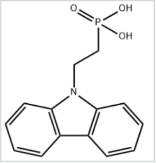
IdentificationPhysical DataSpectraRoute of Synthesis (ROS)Safety and HazardsOther Data
Identification
Product Name2PACzIUPAC Name2-carbazol-9-ylethylphosphonic acidMolecular StructureCAS Registry Number 20999-38-6EINECS NumberMDL NumberBeilstein Registry NumberSynonyms2PACz20999-38-6(2-(9H-Carbazol-9-yl)ethyl)phosphonic acid2-carbazol-9-ylethylphosphonic acidphosphonic acidSCHEMBL25193015MFCD326618682-(carbazol-9-yl)ethylphosphonic acidSB66277C3663CS-0373792F88683Phosphonic acid, (2-carbazol-9-ylethyl)- (8CI)Molecular FormulaC14H14NO3PMolecular Weight275.24InChI InChI=1S/C14H14NO3P/c16-19(17,18)10-9-15-13-7-3-1-5-11(13)12-6-2-4-8-14(12)15/h1-8H,9-10H2,(H2,16,17,18)InChI KeyKIMPAVBWSFLENS-UHFFFAOYSA-NIsomeric SMILESC1=CC=C2C(=C1)C3=CC=CC=C3N2CCP(=O)(O)O
Patent InformationPatent IDTitlePublication DateWO2023/226000ORGANIC COMPOUND AND USE THEREOF, PASSIVATION FILM, SOLAR CELL AND ELECTRONIC DEVICE2023
Physical Data
AppearanceWhite to blue powder to crystalline
Spectra
Description (NMR Spectroscopy)Nucleus (NMR Spectroscopy)Chemical shifts1H
Route of Synthesis (ROS)
ConditionsYieldWith trimethylsilyl bromide In dichloromethane for 6h; Inert atmosphere;Experimental Procedure2.2. Synthesis of (2-(9H-carbazol-9-yl)ethyl)phosphonic acidTo diethyl(2-(9H-carbazol-9-yl)ethyl)-phosphonate (3.32 g, 10mmol) in dry CH2Cl2 (20mL) trimethylsilylbromide (2.90 mL, 22 mmol) was added under N2. The solutionwas stirred for 6 h before being quenched with MeOH and stirredvigorously. After a further 2 h stirring the solvent was removedunder reduced pressure and water (5 mL) was added. The mixturewas then concentrated under reduced pressure. This step wasrepeated four times to give (2-(9H-carbazol-9-yl)ethyl)phosphonicacid as an off-white solid. The solid was recrystallized with waterto give the white solid (2.91 g, 90.94%). 1H NMR (DMSO, 400 MHz):8.16 (d, 2H, J = 8.0 Hz), 7.56 (d, 2H, J = 12 Hz), 7.48 (t, 2H,J = 8.0 Hz), 7.22 (t, 2H, J = 8.0 Hz), 4.50-4.54 (m, 2H), 2.01-2.09(m, 2H) ppm. 13C NMR: 139.85, 126.32, 122.73, 120.88, 119.42,109.39, 37.83, 28.40 ppm. 31PNMR: 24.05 (s). Anal. Calc. for C14H14NO3P: C, 61.09; H, 5.13; N, 5.09. Found: C, 60.88; H, 5.00; N, 5.20%.IR (KBr, cm1): 3415.3(s), 3048.7(w), 1618.9(vs), 1457.9(s), 1328.3(w), 1256.6(m), 1179.6(s), 1130.2(m), 1028.1(s), 950.4(s), 745.6(s),721.9(s), 616.9(s), 499.6(s).90.94%With sodium hydroxide In ethanol at 60℃;Experimental ProcedureDissolve 1g of 2-(9H-carbazole-9-ethyl)phosphonic acid diethyl ester in 20 mL of ethanol , add 10 mL NaOH saturated solution, react at 60°C for 24 hours, then add hydrochloric acid dropwise to adjust the pH to acidic, remove the solvent by rotary evaporation after the reaction, then dissolve it in dichloromethane, wash with saturated brine, and then anhydrous The crude product was obtained after drying over magnesium sulfate and concentrating to remove most of the solvent. The crude product was subjected to column purification. The mobile phase was a mixture of ethyl acetate and n-hexane with a volume ratio of 1:4.
Safety and Hazards
Pictogram(s)SignalWarningGHS Hazard StatementsH315 (100%): Causes skin irritation H319 (100%): Causes serious eye irritation H335 (50%): May cause respiratory irritation Precautionary Statement CodesP261, P264, P264+P265, P271, P280, P302+P352, P304+P340, P305+P351+P338, P319, P321, P332+P317, P337+P317, P362+P364, P403+P233, P405, and P501(The corresponding statement to each P-code can be found at the GHS Classification page.)
Other Data
TransportationUnder room temperature away from lightHS CodeStorageUnder room temperature away from lightShelf Life1 yearMarket Price
DruglikenessLipinski rules componentMolecular Weight275.244logP2.308HBA4HBD2Matching Lipinski Rules4Veber rules componentPolar Surface Area (PSA)72.27Rotatable Bond (RotB)3Matching Veber Rules2
Use Pattern2PACz CAS#: 20999-38-6, self-Assembled Monolayer (SAM) Forming Agents Making Tin-Based Perovskite Solar Cells Efficient. It can form a uniform thin film on solid surfaces, dispersing solid particles in liquids and preventing their aggregation and it can decrease the surface tension of liquids, aiding in their wetting and penetration into the microscopic pores of material surfaces. the application of (2-(9H-carbazol-9-yl)ethyl)phosphonic acid in the interface layer can enhance product performance and stability, providing a better user experience and prolonged service life.
https://www.chemwhat.com/2pacz-cas-20999-38-6/
Comments
Post a Comment